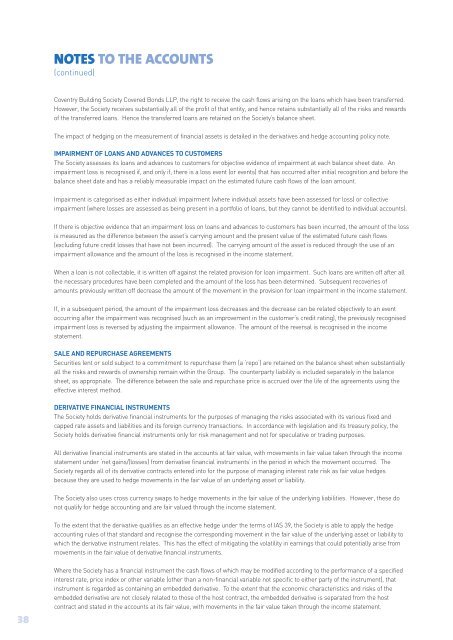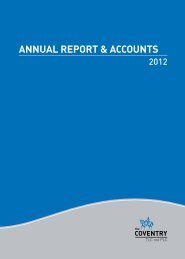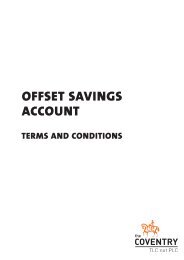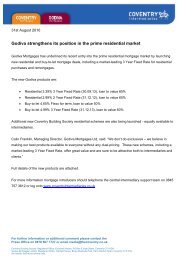Annual report and accounts 2009 (PDF) - Coventry Building Society
Annual report and accounts 2009 (PDF) - Coventry Building Society
Annual report and accounts 2009 (PDF) - Coventry Building Society
You also want an ePaper? Increase the reach of your titles
YUMPU automatically turns print PDFs into web optimized ePapers that Google loves.
NOTES TO THE ACCOUNTS(continued)<strong>Coventry</strong> <strong>Building</strong> <strong>Society</strong> Covered Bonds LLP, the right to receive the cash flows arising on the loans which have been transferred.However, the <strong>Society</strong> receives substantially all of the profit of that entity, <strong>and</strong> hence retains substantially all of the risks <strong>and</strong> rewardsof the transferred loans. Hence the transferred loans are retained on the <strong>Society</strong>’s balance sheet.The impact of hedging on the measurement of financial assets is detailed in the derivatives <strong>and</strong> hedge accounting policy note.IMPAIRMENT OF LOANS AND ADVANCES TO CUSTOMERSThe <strong>Society</strong> assesses its loans <strong>and</strong> advances to customers for objective evidence of impairment at each balance sheet date. Animpairment loss is recognised if, <strong>and</strong> only if, there is a loss event (or events) that has occurred after initial recognition <strong>and</strong> before thebalance sheet date <strong>and</strong> has a reliably measurable impact on the estimated future cash flows of the loan amount.Impairment is categorised as either individual impairment (where individual assets have been assessed for loss) or collectiveimpairment (where losses are assessed as being present in a portfolio of loans, but they cannot be identified to individual <strong>accounts</strong>).If there is objective evidence that an impairment loss on loans <strong>and</strong> advances to customers has been incurred, the amount of the lossis measured as the difference between the asset’s carrying amount <strong>and</strong> the present value of the estimated future cash flows(excluding future credit losses that have not been incurred). The carrying amount of the asset is reduced through the use of animpairment allowance <strong>and</strong> the amount of the loss is recognised in the income statement.When a loan is not collectable, it is written off against the related provision for loan impairment. Such loans are written off after allthe necessary procedures have been completed <strong>and</strong> the amount of the loss has been determined. Subsequent recoveries ofamounts previously written off decrease the amount of the movement in the provision for loan impairment in the income statement.If, in a subsequent period, the amount of the impairment loss decreases <strong>and</strong> the decrease can be related objectively to an eventoccurring after the impairment was recognised (such as an improvement in the customer’s credit rating), the previously recognisedimpairment loss is reversed by adjusting the impairment allowance. The amount of the reversal is recognised in the incomestatement.SALE AND REPURCHASE AGREEMENTSSecurities lent or sold subject to a commitment to repurchase them (a ‘repo’) are retained on the balance sheet when substantiallyall the risks <strong>and</strong> rewards of ownership remain within the Group. The counterparty liability is included separately in the balancesheet, as appropriate. The difference between the sale <strong>and</strong> repurchase price is accrued over the life of the agreements using theeffective interest method.DERIVATIVE FINANCIAL INSTRUMENTSThe <strong>Society</strong> holds derivative financial instruments for the purposes of managing the risks associated with its various fixed <strong>and</strong>capped rate assets <strong>and</strong> liabilities <strong>and</strong> its foreign currency transactions. In accordance with legislation <strong>and</strong> its treasury policy, the<strong>Society</strong> holds derivative financial instruments only for risk management <strong>and</strong> not for speculative or trading purposes.All derivative financial instruments are stated in the <strong>accounts</strong> at fair value, with movements in fair value taken through the incomestatement under ‘net gains/(losses) from derivative financial instruments’ in the period in which the movement occurred. The<strong>Society</strong> regards all of its derivative contracts entered into for the purpose of managing interest rate risk as fair value hedgesbecause they are used to hedge movements in the fair value of an underlying asset or liability.The <strong>Society</strong> also uses cross currency swaps to hedge movements in the fair value of the underlying liabilities. However, these donot qualify for hedge accounting <strong>and</strong> are fair valued through the income statement.To the extent that the derivative qualifies as an effective hedge under the terms of IAS 39, the <strong>Society</strong> is able to apply the hedgeaccounting rules of that st<strong>and</strong>ard <strong>and</strong> recognise the corresponding movement in the fair value of the underlying asset or liability towhich the derivative instrument relates. This has the effect of mitigating the volatility in earnings that could potentially arise frommovements in the fair value of derivative financial instruments.38Where the <strong>Society</strong> has a financial instrument the cash flows of which may be modified according to the performance of a specifiedinterest rate, price index or other variable (other than a non-financial variable not specific to either party of the instrument), thatinstrument is regarded as containing an embedded derivative. To the extent that the economic characteristics <strong>and</strong> risks of theembedded derivative are not closely related to those of the host contract, the embedded derivative is separated from the hostcontract <strong>and</strong> stated in the <strong>accounts</strong> at its fair value, with movements in the fair value taken through the income statement.
















